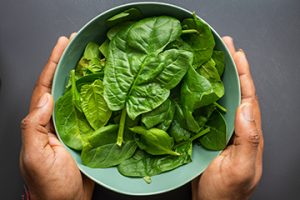 There are a lot of foods that are high in iron, such as shellfish, liver and other organ meats, beef, turkey and fish. That’s normally where many people get iron in their diet. What about a vegetarian? What foods should they eat to get their daily supply of iron? Iron is important for the body. It is necessary in the blood to carry oxygen throughout the body. A deficiency leads to anemia and fatigue. Most at risk are menstruating women and people with certain conditions. There are some rich sources of iron in the plant world, however.
There are a lot of foods that are high in iron, such as shellfish, liver and other organ meats, beef, turkey and fish. That’s normally where many people get iron in their diet. What about a vegetarian? What foods should they eat to get their daily supply of iron? Iron is important for the body. It is necessary in the blood to carry oxygen throughout the body. A deficiency leads to anemia and fatigue. Most at risk are menstruating women and people with certain conditions. There are some rich sources of iron in the plant world, however.
Plant sources are non-heme iron sources that make it harder to absorb.
Popeye loved his spinach and the iron in it made him strong. It does have a significant amount of iron, about 15% of the DV in just 3.5 ounces of spinach. It also contains vitamin C. Even though spinach is non-heme, the vitamin C helps boost the iron absorption. Spinach also has other nutrients, such as carotenoids. Just like spinach, other leafy greens, like kale, Swiss chard, beet and collard greens, tend to be higher in iron. 100 grams of spinach has 1.1 times more iron as 100 grams of red meat. The difference comes in the volume and how well the body can use the iron. Uncooked, 100 grams of spinach is about 3 ½ cups, while 100 grams of red meat is the size of a deck of cards.
Beans, lentils and peas are higher in iron.
Soybeans and the foods like tofu, tempeh and natto made from soybeans are higher in iron. They are also a good source of protein, calcium, magnesium and phosphorous. Lentils, another staple on the vegetarian table, also contain iron, fiber, folate, manganese and protein. Whether you’re talking about black-eyed peas, chickpeas, Lima, red or navy beans, they’re higher in iron. In fact, chickpeas are an excellent source, with a cup providing over 1/4th the daily required amount. Think hummus and dip your veggies as you get your iron.
Your trail mix could be the key to getting adequate iron.
Both nuts and seeds are high in iron. Just two tablespoons of pumpkin, sesame, flax or hemp seed, you’ll get between 7 and 23% of your required daily amount of iron. Again, think about hummus. It’s not only made from chickpeas, but it also contains tahini, a product made from sesame seeds. A half cup of hummus provides 17% of the RDI. Almonds, cashews, macadamia nuts and pine nuts also provide about 8% of the daily recommended intake per ounce.
While raw tomatoes don’t contain a lot of iron, their concentrate does. Just a half cup of tomato paste offers 22% of the RDI. While they do contain vitamin C that helps absorption, it’s lost during the cooking process.
Mash those potatoes with the skin on it. Unpeeled potatoes have a significant amount of iron, approximately 18% of the RDI. Most of that iron is in the skins.
Prune juice and mulberries also have iron. Prunes juice offers about 17% of the RDI per cup, while mulberries provide 14% RDI with a high amount of vitamin C to help absorption.
Whole grains like the ancient grains amaranth, quinoa and spelt, as well as oats, contain a high amount of iron. Let’s not forget one of the more popular foods with iron, dark chocolate. It offers 18% RDI per ounce.
For more information, contact us today at Next Level Fitness
